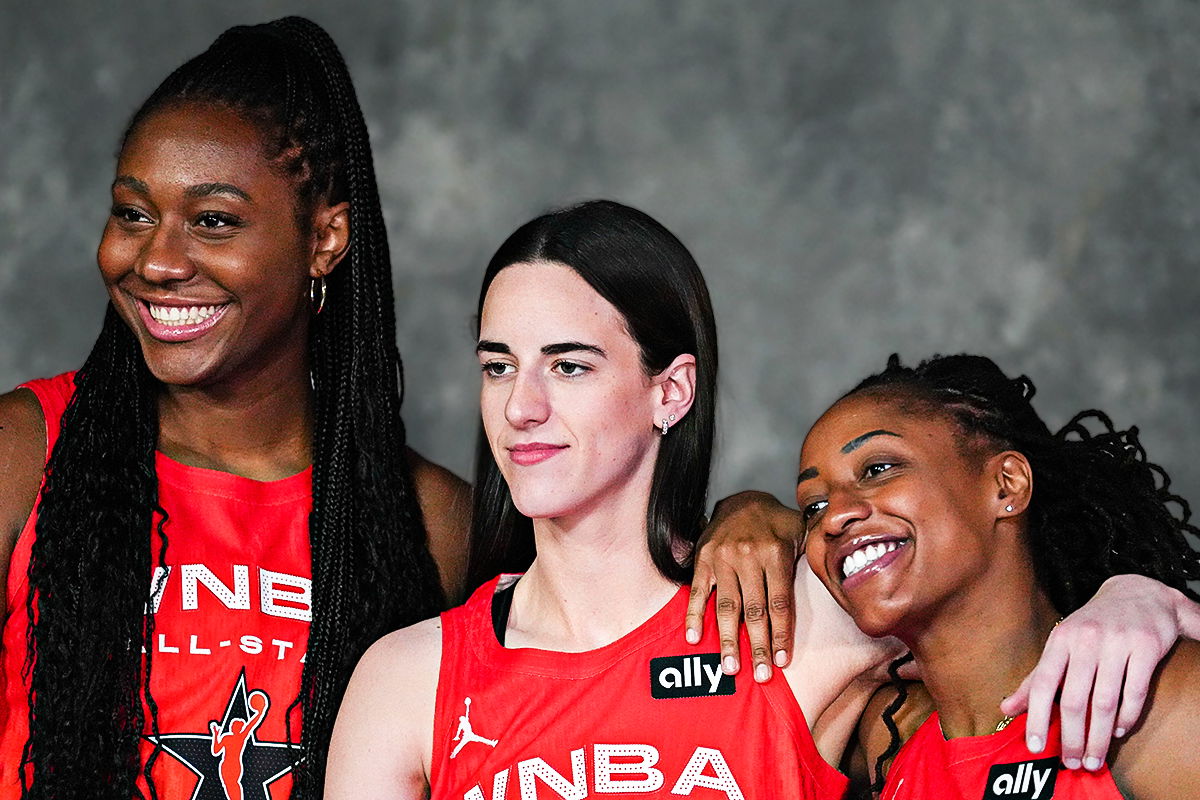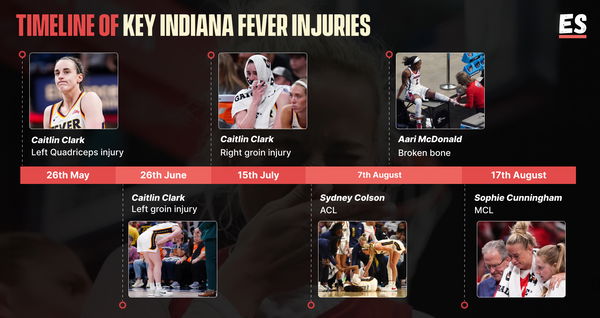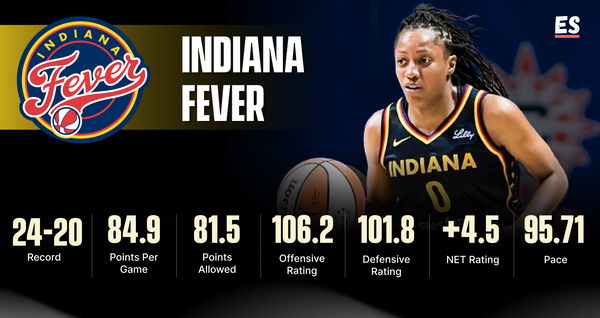
Imago
Credits: Imagn

Imago
Credits: Imagn
When the Indiana Fever hit the offseason, their young core of Caitlin Clark, Aliyah Boston, and Kelsey Mitchell had one simple, non-negotiable demand. They didn’t want a superstar thrown into the mix. They didn’t want someone shaking up the chemistry they had carefully built. All they wanted was respect for what they’d started.
Watch What’s Trending Now!
“The young group that we’re bringing back asked us, ‘Protect our locker room. Protect the culture that we’ve got started,” Fever president Kelly Krauskopf said back in February.
The Fever’s offseason plan was simple but ambitious: surround their young core with experienced veterans who could lift the team while trusting that Caitlin Clark, Aliyah Boston, and Kelsey Mitchell would grow into leaders capable of taking Indiana to a championship. And they executed it perfectly. DeWanna Bonner and Natasha Howard came in, both carrying championship experience, while Sophie Cunningham, Sydney Colson, and Brianna Turner rounded out the bench.
ADVERTISEMENT
On paper, the Fever looked ready to take off. But once the season tipped, things didn’t exactly go as planned, at least initially…
Recapping the Indiana Fever’s Rollercoaster 2025 Season
Heading into the season, ESPN’s BPI had the Fever sitting pretty, ranked sixth overall, with a 91% chance to make the playoffs and a projection of 23.8 wins. But the way the season had started, not many expected them to reach that mark.
ADVERTISEMENT
Caitlin Clark was battling nagging quad and groin injuries, and DeWanna Bonner barely got going, suiting up for just nine games before deciding to leave and join the Mercury.

Imago
Credits: Imagn
As the season wore on, things went from bad to worse for the Fever. By mid-August, injuries had piled up. Sophie Cunningham and Sydney Colson were both ruled out for the season, along with hardship signees Aari McDonald and Chloe Bibby.
ADVERTISEMENT
Then came the biggest blow–Caitlin Clark re-injured her groin, ending her highly anticipated sophomore campaign. She played in just 13 of the Fever’s 44 regular-season games, and by the time the team officially shut her down, many had already written Indiana off as a lost cause.
But the Fever were never the type to quit. “When one person goes down, we say it all the time, the next woman stands up,” Aliyah Boston said, perfectly capturing the team’s mentality. And they lived up to it. Boston and Kelsey Mitchell both finished the season as All-WNBA selections, the first Fever duo to earn that honor in the same season since 2010, and they were the driving force behind Indiana’s surprising success.
ADVERTISEMENT
Against all odds, the Fever still hit 24 wins and finished sixth, exactly what ESPN had predicted. Aliyah Boston truly stepped up, emerging as one of the league’s top centers. In her third season with Indiana, she posted career highs with 15 points, 8.2 rebounds, and 3.7 assists per game, and became the youngest center in the last decade to make an All-Defensive Team.
Meanwhile, Kelsey Mitchell, the league’s highest-paid player this season, carried the offense on her shoulders, averaging a franchise-best 20.2 points per game and scoring a total of 1,068 points, guiding the Fever to the playoffs in Caitlin Clark’s absence.

Imago
Via Imagn. Edited by EssentiallySports Graphics Desk. WNBA Playoffs, Indiana Fever
Making the playoffs was the bare minimum for a Fever team built the way theirs was. With the talent they’d assembled, anything less would have been a disappointment. But considering everything they went through this season, their postseason run became something to be truly proud of. And that’s exactly where Indiana showed what they were made of. They shocked the No. 3-seed Atlanta Dream in three games, sealing the series on the road with a gutsy comeback.
ADVERTISEMENT
In the first round, the Fever dropped Game 1 to the Atlanta Dream but bounced back to win the next two, becoming the first lower seed to advance since the WNBA returned to best-of-three first-round series in 2022. Aliyah Boston’s game-winner in the final seconds of Game 3 capped an incredible last-minute comeback–and delivered Indiana its first playoff series win in a decade.
Then they pushed the No. 2-seed and eventual champion Las Vegas Aces to the limit, taking the semifinals all the way to five games before finally falling in overtime, completely drained after giving everything they had.
ADVERTISEMENT
“[The season] showed the kind of character we have–the toughness, the relentless spirit, the flexibility, the versatility, the coachability,” coach Stephanie White said after her first season back with the organization. And she had a point.
Whatever doubts or criticisms hovered over the Fever during the regular season, they proved their mettle when it mattered most. Their improbable playoff run was the perfect ending to a season defined by grit, resilience, and overcoming every challenge thrown their way.
So, was the Fever’s 2025 season a success? That really depends on how you look at it. Some might say they underachieved, given the hype surrounding them at the start of the year. Others would call them overachievers for what they actually accomplished. For us, it was a mix of both. A team that stumbled through the regular season yet came within a whisker of the WNBA Finals with a depleted roster. They weren’t the powerhouse many expected, but somehow, against all odds, they still contended for a championship.
ADVERTISEMENT
But what’s next?
The next chapter for Caitlin Clark and Co.
Injuries battered the Fever so badly this season that they rolled with nine different starting lineups and 16 players on the roster. But this season also showed that they are much more than just “Caitlin Clark’s team.” Looking ahead, Indiana enters what could be a tumultuous offseason in a surprisingly strong position.
ADVERTISEMENT
Aside from rookies, the only other players in the league with guaranteed contracts next season are Kalani Brown in Phoenix and Lexie Brown in Seattle. But the Fever can take comfort knowing they’ll have Caitlin Clark, Aliyah Boston, and Makayla Timpson locked in for 2026.
But the other 13 players who helped the Fever achieve the impossible will be hitting the market, and there are some big names among them.
- Kelsey Mitchell (unrestricted)
- Sophie Cunningham (unrestricted)
- Natasha Howard (unrestricted)
- Lexie Hull (restricted)
- Aari McDonald (unrestricted)
- Odyssey Sims (unrestricted)
- Damiris Dantas (unrestricted)
If you’re wondering about the difference between unrestricted and restricted free agents, here’s the lowdown. An unrestricted free agent can sign with any team on any terms; they’re free to go wherever they want. A restricted free agent, however, can get offers from other teams, but their current team has the right to match any deal, basically giving them the final say and turning it into a team option.
Moving on, Lexie Hull looks set to return, having made it clear that Indiana is where she wants to be. “I’ve built a life here, and I love this franchise,” Hull told IndyStar’s Chloe Peterson. “I love the people, I love the fans, so we’ll see what comes.” With the friendly terms of her contract, it’s hard to imagine a future where this reunion won’t happen.
But the same can’t be said about their MVP contender, Kelsey Mitchell. She is an unrestricted free agent for the second year in a row, and once again, Fever general manager Amber Cox made it clear that the team will do everything in its power to bring her back.
“I’m going to sound like a broken record from last year. The priority will be Kelsey Mitchell, and making sure she remains in a Fever jersey,” Cox said during her exit interview.
But the eight-year veteran–who became the first guard in WNBA history to record 850+ points and 150+ assists in a single season, and the first in league history to make 100 three-pointers 3 times in her career–has made no promises about returning. She did, however, call Indiana her second home. Much of the Fever’s offseason work will likely focus on making sure Kelsey Mitchell comes back, keeping their core intact for another run.
But what about the rest of the roster? Indiana’s self-proclaimed protector, Sophie Cunningham, has expressed her desire to return. Aari McDonald and Odyssey Sims provided solid options in the backcourt, while Natasha Howard brought the veteran defensive presence the Fever desperately needed last season.
Will they be back? A lot of that will depend on the outcome of the current CBA negotiations. As of now, there’s no indication a deal will be reached before the October 31 deadline, so the wait continues.
Of course, no one can predict exactly how the offseason will unfold–which is why the Fever’s 2025 season is so significant. They have a solid core, one of the league’s top coaches, and a fan base and management fully committed to the team. As the league enters uncharted territory, having that foundation in place could make all the difference.
Essentially Sports’ take
Now look, we understand that there’s a lot of uncertainty heading into this offseason. No one knows for sure if the league will even start the next season, with the possibility of a lockout growing by the day. But there’s reason for hope. The WNBA has been here before, taking a 60-day extension to finalize a deal under Cathy Engelbert’s leadership, so a resolution could still be on the horizon.
The salary cap for next season will play a huge role in determining how much these players can earn and what kind of team the Fever can put together. With the cap expected to rise, having Clark and Boston on rookie-scale contracts could be a massive advantage. It gives the Fever flexibility–not just to bring Mitchell back–but also to upgrade the roster with higher-quality players and make a real push next season.
Looking ahead, multi-year contracts are likely to become the norm among free agents if the CBA negotiations reach an agreement, and that will instantly make the Fever a desirable free agent destination. Not because they have Caitlin Clark (of course, that is a big draw), but because they have a new training facility coming up in 2027 as well. Building practice facilities has become the latest arms race in the WNBA.
The Las Vegas Aces and the Phoenix Mercury were actually the first two teams to do it, and you won’t get brownie points for guessing which two teams played in the finals. Since the inauguration of their $40 million facility, the Aces have won 2 championships already, showing that building off the court is just as important as on it.
The Fever will also enter the upcoming draft with the 10th, 25th, and 40th picks. Used wisely, those selections could net them a strong contributor, a trade asset, or even uncover a hidden gem. But beyond just retaining their core, which is obviously a given, there are a few other areas we’d like the Fever to focus on this offseason.
- Fever Must Spread the Load Beyond Their Stars: The Mitchell-Clark backcourt duo was the most efficient in the league in 2024, and the Fever relied on them for nearly all of their offensive firepower. But when both have an off night, the team struggles.
To avoid that, Indiana needs a third ball-handler, ideally a combo guard or wing who can shoot, defend, and run the offense in secondary actions. Odyssey Sims showed she can do exactly that during the Fever’s Cinderella playoff run–but whether Indiana brings her back is still up in the air.
- Keeping Players Healthy: Everyone knows how brutal the injury crisis was for the Fever this season. Some injuries were just bad luck, while others happened because the team had no choice but to play certain players due to limited options.
To prevent a repeat next season, Indiana needs to prioritize load management and invest heavily in full-time strength and conditioning coaches, recovery experts, physical therapists, and medical staff who can use real-time data to track fatigue and prevent breakdowns. And having a top-tier training facility ready before 2027 will be a huge part of that effort.
- Be better closing games: There’s been a clear pattern in quite a few of the Fever’s losses this season: they stay close, get comfortable, and then fall apart down the stretch. A prime example came in late June against the Valkyries, when Indiana gave up 33 points in the fourth quarter.
Offensively, the team too often became predictable, leaning on isolations or forced threes late in the game. Going forward, Stephanie White needs to diversify the playbook, adding more movement, cutting, and structured sets designed to exploit mismatches.
If the Fever can address these issues while keeping their core intact, there’s no reason they won’t be championship favorites again next season. Think we missed something? Drop your thoughts in the comments below! We want to hear from you!
ADVERTISEMENT
ADVERTISEMENT
ADVERTISEMENT

